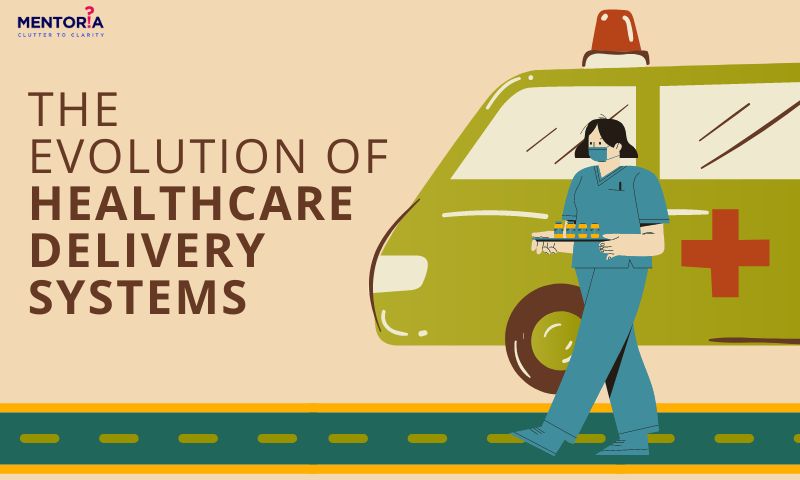The Evolution Of Healthcare Delivery Systems

Healthcare isn’t what it used to be. It’s a dynamic field that adapts to new challenges, embraces cutting-edge technology, and prioritises accessibility for everyone. Think of it as an ongoing upgrade – like getting the latest version of your favourite app but for your well-being. Let’s dive into the riveting world of healthcare evolution – because it’s not just a passing trend, it’s a full-blown necessity! Technological advancements are racing at warp speed, demographics are rising, and patients’ needs are growing like never before. What’s the result? An absolute healthcare makeover! So, in this blog, we’re dissecting the very DNA of healthcare evolution.
Evolution Of Healthcare Delivery Systems
Adapting To Change
In the ever-shifting landscape of healthcare, adaptation emerges as the centre for resilience. Health systems, like living organisms, must attune themselves to the change. The rise of new diseases, demographic shifts, and emerging healthcare needs necessitate an organisational culture that embraces innovation and flexibility. The heartbeat of a thriving healthcare system is its ability to pulse in line with the dynamic needs of its patients. Additionally, data from the World Health Organization (WHO) indicates that countries with adaptable healthcare systems were more successful in responding to the COVID-19 pandemic, emphasising the crucial role of adaptability in healthcare resilience. By fostering a culture that encourages adaptability, healthcare providers not only respond effectively to current challenges but also position themselves to navigate the uncertainties of the future with agility and precision.
- Patient-Centred Care Models: Evolving healthcare systems prioritise patient-centred care models that involve patients in decision-making processes, fostering a sense of partnership in their healthcare journey.
- Real-time Data Analytics: The integration of real-time data analytics enables healthcare providers to quickly identify emerging healthcare trends and allocate resources efficiently, contributing to proactive and responsive care.
The Tech Revolution
We stand at the edge of a healthcare revolution, driven by transformative technologies. Digital health innovations, ranging from telemedicine to artificial intelligence, are not merely buzzwords but catalysts reshaping the healthcare landscape. These technologies hold the promise of revolutionising care delivery, enhancing patient outcomes, and ushering in unprecedented levels of efficiency. A report by McKinsey highlights that the adoption of digital health technologies, including telemedicine and artificial intelligence, can result in a 20% increase in healthcare efficiency. The healthcare scenario expands as we wholeheartedly embrace these innovations, opening new vistas for personalised care, patient empowerment, and a more interconnected healthcare ecosystem. The tech revolution is a transformative journey towards a future where technology becomes an integral part of the healthcare narrative.
- Remote Patient Monitoring: Healthcare systems are increasingly adopting remote patient monitoring technologies, allowing for continuous tracking of patient health metrics. This not only enhances patient outcomes but also reduces the burden on in-person healthcare services.
- Interconnected Electronic Health Records (EHR): Seamless EHR systems facilitate the secure exchange of patient information among healthcare providers, promoting continuity of care and minimising redundancies in medical procedures.
Prioritising Accessibility by Bridging Gaps In Care
A truly evolved healthcare system is one that dismantles barriers to access, ensuring that quality care is within reach for all. Regardless of socioeconomic status or geographic location, every individual deserves the assurance that healthcare is not a distant privilege but a tangible right. This involves a concerted effort to address healthcare disparities, providing a level playing field for vulnerable populations. The Lancet’s Global Health Observatory indicates that countries prioritising health care accessibility witness a significant reduction in health disparities. By prioritising accessibility, healthcare systems elevate themselves from mere structures to representatives where everyone gets access to the benefits of a healthy and equitable society.
- Telehealth Initiatives: The evolution of healthcare includes widespread implementation of telehealth initiatives, ensuring that individuals in remote or underserved areas can access timely medical consultations and follow-ups.
- Community Health Workers: Integrating community health workers into healthcare systems enhances accessibility, especially among vulnerable populations. These workers act as bridges, connecting communities with healthcare services and resources.
Streamlining Efficiency and Navigating Resources
Efficiency guides healthcare organisations through the intricate variety of resources. In a world where resources are finite, optimising their utilisation is paramount. Research published in the British Medical Journal highlights that collaborative healthcare environments, including multidisciplinary care teams, lead to a 40% improvement in patient outcomes. From trimming administrative burdens to minimising unnecessary procedures, a streamlined healthcare system ensures that every action is purposeful and every resource is directed where it matters most – providing exceptional patient care. This commitment to efficiency is not a mere exercise in resource management; it’s a strategic navigation, ensuring that the journey through the complex healthcare landscape is as smooth and effective as possible.
- Lean Healthcare Practices: The application of lean principles in healthcare, inspired by manufacturing efficiency models, optimises processes and reduces waste, contributing to resource efficiency without compromising patient care quality.
- Predictive Analytics: Implementing predictive analytics in healthcare management enables the anticipation of patient needs and trends, allowing for proactive resource allocation and preventing potential bottlenecks in care delivery.
Fostering Collaboration In Healthcare
Healthcare, at its core, is a collaborative endeavour. Care resonates most harmoniously when healthcare providers, policymakers, and other stakeholders join forces. From fostering multidisciplinary care teams to engaging patients in decision-making, collaboration becomes the cornerstone of a responsive and patient-centric healthcare ecosystem. This collaboration extends beyond the confines of hospital walls, reaching out to form partnerships with community organisations. Together, they address the intricate interplay of social determinants of health, ensuring that healthcare is not just accessible within clinical spaces but throughout communities, fostering a holistic approach to well-being.
- Interdisciplinary Training Programmes: Healthcare professionals are participating in interdisciplinary training programmes, fostering collaboration and ensuring that diverse perspectives contribute to holistic patient care.
- Shared Decision-Making Platforms: Healthcare systems are implementing shared decision-making platforms that involve patients in care decisions, creating a collaborative environment where providers and patients work together to achieve optimal health outcomes.
Building Accountability and Trust In Transparency
Trust is the bedrock upon which a flourishing healthcare system stands. Transparency, accountability, and a commitment to continuous quality improvement form the pillars of this trust. It involves a willingness to measure and report on key quality metrics openly, inviting scrutiny and feedback. Listening to the voices of patients and implementing evidence-based practices are integral elements of this accountability. It’s not just about meeting standards; it’s about surpassing them, continuously striving for excellence. A study by The Commonwealth Fund reveals that accountable healthcare systems experience a 20% decrease in medical errors, emphasising the importance of transparency in ensuring patient safety. This commitment to transparency and accountability builds a bridge of trust between healthcare providers and the communities they serve, fostering a relationship that transcends mere transactions, creating enduring connections rooted in confidence and shared values.
- Patient Feedback Mechanisms: Healthcare systems are embracing patient feedback mechanisms, providing patients with a platform to share their experiences and concerns. This transparency builds trust and allows for continuous improvement.
- Publicly Available Quality Metrics: Making quality metrics publicly available enhances accountability, allowing patients and stakeholders to assess and compare the performance of healthcare systems, fostering a culture of continuous improvement.
The Ongoing Journey Of Healthcare Evolution
Reflecting on the evolution of healthcare delivery systems, it becomes evident that the journey is ongoing. Adaptation to change, embracing innovation, prioritising accessibility, streamlining efficiency, fostering collaboration, building accountability, and being rooted in evidence collectively shape a healthcare system that is not just responsive but compassionate. The future of healthcare lies in our collective commitment to adaptability, innovation, and a patient-centric approach, ensuring that healthcare remains a beacon of hope and healing for generations to come.









